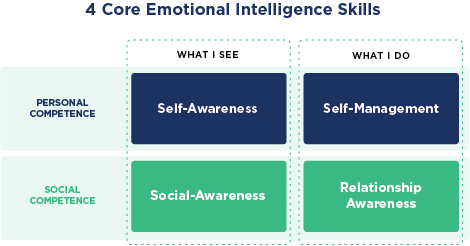In 2025, the pace of work feels faster than ever, and so does the emotional climate. Artificial intelligence is reshaping entire roles, return-to-office mandates are testing workplace trust, Gen Z is bringing fresh perspectives (and fresh expectations) into the mix, and global uncertainty continues to keep leaders on their toes.
In times like these, technical skills and knowledge alone aren’t enough to thrive. High emotional intelligence (EQ) or the ability to recognize, understand, and manage your own emotions and the emotions of others, has become a strategic advantage. It’s not just a “nice-to-have” soft skill anymore; it’s the difference between leaders who can navigate constant change with confidence and those who get stuck in the churn.
And while the basics of EQ haven’t changed, how high EQ shows up in today’s world looks a little different. Let’s break it down.
The 4 Skills of Emotional Intelligence—Still the Core
At TalentSmartEQ, we measure EQ across four core skills:
- Self-Awareness – Accurately perceiving your own emotions in the moment and understanding your tendencies across situations.
- Self-Management – Using awareness of your emotions to stay flexible and direct your behavior positively.
- Social Awareness – Accurately picking up on emotions in other people and understanding what’s really going on.
- Relationship Management – Using awareness of your own and others’ emotions to manage interactions successfully.

These skills remain timeless—but in 2025, the situations that test them are evolving.
High EQ in Today’s Workplace: Real-World Stories
- Navigating AI Disruption with Self-Awareness
Last year, a marketing manager named Priya watched her team’s role shift overnight as AI-driven tools took over repetitive tasks. While some colleagues went into defensive mode, Priya recognized her own rising anxiety for what it was: fear of becoming irrelevant. Because she could name and understand her reaction, she didn’t let it drive rash decisions. Instead, she leaned into upskilling, positioning herself as the team’s AI-integration lead. Today, she’s not only relevant, she’s indispensable. - Balancing Return-to-Office Mandates with Relationship Management
Ethan, a director at a tech firm, faced a tough assignment: enforce a three-day in-office policy for a team that had been fully remote for three years. Rather than send a blanket email, he met with small groups, listened to concerns, and co-created solutions, like quiet zones for focus work and staggered in-office schedules for parents. By keeping the focus on trust and collaboration, Ethan saw his team’s engagement scores rise, even in the midst of a major change. - Bridging Generational Perspectives with Social Awareness
When Gen Z hires joined her project team, mid-career consultant Janelle noticed frustration from older colleagues who thought the newcomers were “too casual” in their approach. Instead of making assumptions, she paid close attention to what younger team members valued—flexibility, purpose, and rapid feedback—and found ways to integrate those preferences into team norms. Productivity increased, and so did mutual respect.
The emotional tone that flows through your organization begins with you, and is directly shaped by your EQ. Now is the time to ask yourself: What kind of emotional tone am I creating here, and how much of it is driven by my current EQ level? The table below outlines common behaviors displayed by leaders in the workplace, contrasting those typically seen in leaders with strong EQ against those observed in leaders with low EQ. Take a close look and consider: Which column reflects most of your daily behavior?

Why This Matters More Than Ever
How you work has never been more important as what you deliver.
- AI adoption is creating more moments where adaptability and emotional resilience are the difference between thriving and feeling left behind.
- Return-to-office shifts are testing leaders’ ability to manage change without eroding trust.
- Generational diversity is amplifying both the challenges and opportunities for connection.
- Global uncertainty means emotional steadiness is now a leadership imperative, not just a personal benefit.
Organizations that invest in EQ training and sustainment see measurable business outcomes: higher engagement, lower turnover, faster change adoption, and yes—healthier EBITDA through better decision-making and stronger client relationships.
Building Your EQ: Where to Start
If you want to strengthen your EQ, here are three practical starting points:
- Schedule Emotional Check-Ins – Once a day, pause and ask yourself: What am I feeling right now, and how is it shaping my behavior?
- Listen Without Loading Your Response – In your next conversation, focus entirely on understanding before you start crafting your reply.
- Close the Feedback Loop – When you receive feedback, reflect back what you heard and one concrete action you’ll take.
These small shifts compound over time, especially in today’s environment where the pace of change rarely slows down.
The Bottom Line
High emotional intelligence is not about being endlessly positive or agreeable; it’s about being aware, adaptable, and intentional in how you navigate yourself and others through complexity.
It’s what allows you to stay grounded in a hybrid meeting where tension runs high, to spot the burnout before it hits your star performer, and to respond to uncertainty without defaulting to fear or resistance.
And the best part? It’s learnable. You can start today.
TalentSmartEQ’s best-selling book Emotional Intelligence 2.0 includes online access to the Emotional Intelligence Appraisal®, a test that measures EQ in the four key areas of self-awareness, self- management, social awareness, and relationship management.